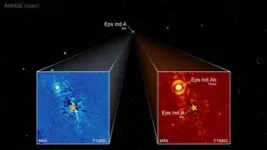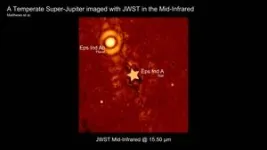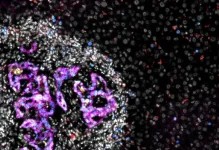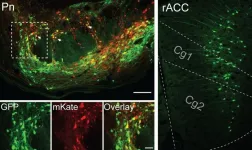(Press-News.org) “We were excited when we realised we had imaged this new planet”, said Elisabeth Matthews, a researcher at the Max Planck Institute for Astronomy in Heidelberg, Germany. She is the main author of the underlying research article published in the journal Nature. “To our surprise, the bright spot that appeared in our MIRI images did not match the position we were expecting for the planet”, Matthews points out. “Previous studies had correctly identified a planet in this system but underestimated this super-Jupiter gas giant’s mass and orbital separation”. With the help of JWST, the team was able to set the record straight.
This detection is quite unusual in several aspects. It shows the first exoplanet imaged with JWST that had not already been imaged from the ground and is much colder than the gas planets JWST has studied so far. An ‘image’ means that the planet appears as a bright dot on the images and thus represents direct evidence. The transit and radial velocity methods are indirect evidence, as the planet only reveals itself through its mediated effect.
JWST observations update previous measurements
The planet revolves around the main component of the nearby triple star system Epsilon Indi, or Eps Ind for short. Astronomical labelling conventions assign the label Eps Ind A to that primary star, a red dwarf star a little smaller and cooler than the sun. To construct the planet’s name, a “b” is appended, resulting in the designation Eps Ind Ab.
The new JWST data are consistent with a super-Jupiter having a mass six times that of Jupiter in the Solar System. Eps Ind Ab orbits its host star on an eccentric, elliptical orbit whose farthest separation from Eps Ind A should range between 20 and 40 astronomical units. One astronomical unit is the mean distance between Earth and the Sun, approximately 150 million kilometres. The new values differ considerably from earlier studies, which is why the team chose to call this a “new” planet.
Cool planets, hot science
Only a few cold gas-giant planets orbiting solar-age stars are known to date, and these have all been inferred indirectly from radial velocity measurements. By imaging and taking spectra of the planets, astronomers can study their atmospheres and trace the evolution of planetary systems compared to computational models. Studying planets in fully settled planetary systems helps tie up loose ends concerning the late stages of planetary evolution and refine our general understanding of planet formation and evolution.
The recent observations lead the way to finding many more of these cold gas-giant planets. These will allow astronomers to study a new class of exoplanets and compare them to the solar system gas giants.
How to detect cold gas planets
However, these planets are hard to find using the classical detection methods. Planets far from their host stars are typically very cold, unlike the hot Jupiters that circle their stars at separations of only a few stellar radii. Wide orbits are highly unlikely to be aligned along the line of sight to produce a transit signal. In addition, measuring their signals with the radial-velocity method is challenging when only a small section of the orbit can be monitored.
Earlier studies attempted to investigate a giant planet orbiting Eps Ind A using radial velocity measurements. However, extrapolating a small part of the orbit led to incorrect conclusions about the planet’s properties. After all, Eps Ind Ab needs around 200 years to orbit its star. Observations over a few years are insufficient to determine the orbit with high precision.
Therefore, the team around Matthews devised a different approach. They wanted to take a picture of the known planet using a method commonly known as direct imaging. Since exoplanet host stars are so bright, they outshine any other nearby object. Regular cameras would be overwhelmed by the blinding starlight.
For this reason, the team employed JWST’s MIRI (Mid-Infrared Instrument) camera equipped with a coronagraph. This light-blocking mask covers the star like an artificial eclipse. Another advantage is Eps Ind’s proximity to Earth, which is only 12 light-years. The smaller the distance to the star, the larger the separation between two objects appears in an image, providing a better chance of mitigating the host star’s interference. MIRI was the perfect choice because it observes in the thermal or mid-infrared, where cold objects shine brightly.
What do we know about Eps Ind Ab?
“We discovered a signal in our data that did not match the expected exoplanet,” says Matthews. The point of light in the image was not in the predicted location. “But the planet still appeared to be a giant planet,” adds Matthews. However, before being able to make such an assessment, the astronomers had to exclude the signal was coming from a background source unrelated to Eps Ind A.
“It is always hard to be certain, but from the data, it seemed quite unlikely the signal was coming from an extragalactic background source,” explains Leindert Boogaard, another MPIA scientist and a co-author of the research article. Indeed, while browsing astronomical databases for other observations of Eps Ind, the team came across imaging data from 2019 obtained with the VISIR infrared camera attached to the European Southern Observatory’s (ESO) Very Large Telescope (VLT). After re-analysing the images, the team found a faint object precisely at the position where it should be if the source imaged with JWST belonged to the star Eps Ind A.
The scientists also attempted to understand the exoplanet atmosphere based on the available images of the planet in three colours: two from JWST/MIRI and one from VLT/VISIR. Eps Ind Ab is fainter than expected at short wavelengths. This could indicate substantial amounts of heavy elements, particularly carbon, which builds molecules such as methane, carbon dioxide, and carbon monoxide, commonly found in gas-giant planets. Alternatively, it might indicate that the planet has a cloudy atmosphere. However, more work is needed to reach a final conclusion.
Plans and prospects
This work is only a first step towards characterising Eps Ind Ab. “Our next goal is to obtain spectra which provide us a detailed fingerprint of the planet’s climatology and chemical composition,” says Thomas Henning, Emeritus Director at MPIA, co-PI of the MIRI instrument, and a co-author of the underlying article.
“In the long run, we hope to also observe other nearby planetary systems to hunt for cold gas giants that may have escaped detection,” says Matthews. “Such a survey would serve as the basis for a better understanding of how gas planets form and evolve.”
Background information
The MPIA scientists involved in this study are Elisabeth Matthews, Leindert Boogaard, and Thomas Henning.
Other researchers include Aarynn Carter (Space Telescope Science Institute, Baltimore, USA), Caroline Morley (University of Texas at Austin, Austin, USA), and Prashant Pathak (Indian Institutes of Technology, Kanpur, India).
The MIRI consortium consists of the ESA member states Belgium, Denmark, France, Germany, Ireland, the Netherlands, Spain, Sweden, Switzerland, and the United Kingdom. The national science organisations fund the consortium’s work – in Germany, the Max Planck Society (MPG) and the German Aerospace Center (DLR). The participating German institutions are the Max Planck Institute for Astronomy in Heidelberg, the University of Cologne, and Hensoldt AG in Oberkochen, formerly Carl Zeiss Optronics.
JWST is the world’s premier space science observatory. It is an international program led by NASA jointly with its partners, ESA (European Space Agency) and CSA (Canadian Space Agency).
END
Webb images nearest super-Jupiter, opening a new window to exoplanet research
The coldest and oldest exoplanet ever imaged agrees with models of planet evolution to solar system ages
2024-07-24
ELSE PRESS RELEASES FROM THIS DATE:
Social vulnerability linked with mental health and substance use disorders
2024-07-24
A new study published in JAMA Psychiatry uncovers significant associations between social vulnerability — a measurement that aggregates social determinants of health like socioeconomic status, housing type, education and insurance coverage — and the prevalence and treatment of mental health and substance use disorders in the United States. The results have the potential to reshape public health policies to better serve systemically disadvantaged populations.
Powerful analysis of meaningful data
“We're continually learning that so much of healthcare — both mental health and physical health — is impacted by the environment ...
Insurance type and withdrawal of life-sustaining therapy in critically injured trauma patients
2024-07-24
About The Study: In this cohort study of U.S. adult trauma patients who were critically injured, patients who were uninsured underwent earlier withdrawal of life-sustaining therapy compared with those with private or Medicaid insurance. Based on the findings of this study, a patient’s ability to pay was likely associated with a shift in decision-making for withdrawal of life-sustaining therapy, suggesting the influence of socioeconomics on patient outcomes.
Corresponding Author: To contact the corresponding author, Graeme Hoit, M.D., email graeme.hoit@mail.utoronto.ca.
To ...
Physician posttraumatic stress disorder during COVID-19
2024-07-24
About The Study: The findings of this study suggest that physicians were more likely to experience posttraumatic stress disorder (PTSD) during the COVID-19 pandemic. Targeted interventions to support physician well-being during traumatic events like pandemics are required.
Corresponding Author: To contact the corresponding author, Manish M. Sood, M.D., email Msood@toh.on.ca.
To access the embargoed study: Visit our For The Media website at this link https://media.jamanetwork.com/
(doi:10.1001/jamanetworkopen.2024.23316)
Editor’s ...
Social isolation changes and long-term outcomes among older adults
2024-07-24
About The Study: Increased isolation was associated with elevated risks of mortality, disability, and dementia, irrespective of baseline isolation status in this cohort study. These results underscore the importance of interventions targeting the prevention of increased isolation among older adults to mitigate its adverse effects on mortality, as well as physical and cognitive function decline.
Corresponding Author: To contact the corresponding author, Judy Zhong, Ph.D., email judy.zhong@nyumc.org.
To access the embargoed study: Visit our For The Media website at ...
Under pressure: how cells respond to physical stress
2024-07-24
Cell membranes play a crucial role in maintaining the integrity and functionality of cells. However, the mechanisms by which they perform these roles are not yet fully understood. Scientists from the University of Geneva (UNIGE), in collaboration with the Institut de biologie structurale de Grenoble (IBS) and the University of Fribourg (UNIFR), have used cryo-electron microscopy to observe how lipids and proteins at the plasma membrane interact and react to mechanical stress. This work shows that, depending on conditions, small membrane regions can stabilize ...
Preventing cancer cells from colonizing the liver
2024-07-24
In brief:
ETH Zurich researchers have discovered proteins on the surface of colorectal cancer cells and liver cells that bind together and that play a major role in the formation of new metastases.
The binding of the proteins triggers fundamental changes in colorectal cancer cells that allow them to take root in the liver.
These new findings will help to develop future treatments that may hinder the formation of often fatal metastases.
In cases where cancer is fatal, nine out of ten times the culprit is metastasis. This is when the primary tumour has sent out cells, like seeds, and invaded other organs of the body. While medicine has made great progress in treating primary tumours, ...
Neuroscientists discover brain circuitry of placebo effect for pain relief
2024-07-24
CHAPEL HILL, NC – The placebo effect is very real. This we’ve known for decades, as seen in real-life observations and the best double-blinded randomized clinical trials researchers have devised for many diseases and conditions, especially pain. And yet, how and why the placebo effect occurs has remained a mystery. Now, neuroscientists have discovered a key piece of the placebo effect puzzle.
Publishing in Nature, researchers at the University of North Carolina School of Medicine– with colleagues from Stanford, the Howard Hughes Medical Institute, and ...
'Gene misbehavior' widespread in healthy people
2024-07-24
Scientists have uncovered that ‘gene misbehaviour’ – where genes are active when they were expected to be switched off – is a surprisingly common phenomenon in the healthy human population.
The team also identify several mechanisms behind these gene activity errors. This may help inform precision medicine approaches and enable the development of targeted therapies to correct expression.
Researchers from the Wellcome Sanger Institute, the University of Cambridge and AstraZeneca studied the activity of inactive genes in a large, healthy population for the first time. While rare at the individual gene level, they revealed misexpression ...
Arc Institute welcomes first Scientific Advisory Board members; appoints two new members to Board of Directors
2024-07-24
Today, Arc Institute, the scientific research organization pioneering new models for scientific discovery and translation, is announcing the creation of its Scientific Advisory Board and its first two Scientific Advisors, as well as the appointment of two new members to the Arc Board of Directors.
New Scientific Advisory Board
Dr. Carolyn Bertozzi, Ph.D., and Dr. Aviv Regev, Ph.D., join as the first two members of Arc’s Scientific Advisory Board and will provide strategic guidance, share their ...
NCCN Oncology Research Program celebrates 25 years of advancing cancer science
2024-07-24
PLYMOUTH MEETING, PA [July 24, 2024] — The National Comprehensive Cancer Network® (NCCN®)—an alliance of leading cancer centers—commemorates the 25th anniversary of the NCCN Oncology Research Program (ORP). The NCCN ORP is dedicated to seeking innovative, effective, and equitable cancer care through oversight and funding for cancer research and quality improvement projects. Over the past quarter-century, the NCCN ORP has managed a diverse portfolio of more than 180 research studies and quality improvement projects to improve quality and outcomes for people with cancer. The NCCN ORP has also provided project oversight to 75 NCCN Foundation® Young Investigator Award ...
LAST 30 PRESS RELEASES:
B cells transiently unlock their plasticity, risking lymphoma development
Advanced AI dodel predicts spoken language outcomes in deaf children after cochlear implants
Multimodal imaging-based cerebral blood flow prediction model development in simulated microgravity
Accelerated streaming subgraph matching framework is faster, more robust, and scalable
Gestational diabetes rose every year in the US since 2016
OHSU researchers find breast cancer drug boosts leukemia treatment
Fear and medical misinformation regarding risk of progression or recurrence among patients with breast cancer
Glucagonlike peptide-1 receptor agonists and asthma risk in adolescents with obesity
Reviving dormant immunity: Millimeter waves reprogram the immunosuppressive microenvironment to potentiate immunotherapy without obvious side effects
Safety decision-making for autonomous vehicles integrating passenger physiological states by fNIRS
Fires could emit more air pollution than previously estimated
A new way to map how cells choose their fate
Numbers in our sights affect how we perceive space
SIMJ announces global collaborative book project in commemoration of its 75th anniversary
Air pollution exposure and birth weight
Obstructive sleep apnea risk and mental health conditions among older adults
How talking slows eye movements behind the wheel
The Ceramic Society of Japan’s Oxoate Ceramics Research Association launches new international book project
Heart-brain connection: international study reveals the role of the vagus nerve in keeping the heart young
Researchers identify Rb1 as a predictive biomarker for a new therapeutic strategy in some breast cancers
Survey reveals ethical gaps slowing AI adoption in pediatric surgery
Stimulant ADHD medications work differently than thought
AI overestimates how smart people are, according to HSE economists
HSE researchers create genome-wide map of quadruplexes
Scientists boost cell "powerhouses" to burn more calories
Automatic label checking: The missing step in making reliable medical AI
Low daily alcohol intake linked to 50% heightened mouth cancer risk in India
American Meteorological Society announces Rick Spinrad as 2026 President-Elect
Biomass-based carbon capture spotlighted in newly released global climate webinar recording
Illuminating invisible nano pollutants: advanced bioimaging tracks the full journey of emerging nanoscale contaminants in living systems
[Press-News.org] Webb images nearest super-Jupiter, opening a new window to exoplanet researchThe coldest and oldest exoplanet ever imaged agrees with models of planet evolution to solar system ages





